Tesco PLC: Vision, Leadership, and Management for People Development
VerifiedAdded on 2021/02/20
|8
|2559
|63
Project
AI Summary
This project report provides a comprehensive analysis of Tesco PLC, a leading British multinational grocery retailer. It delves into Tesco's history, vision, leadership styles, management practices, and organizational culture. The report examines how Tesco's vision, leadership, and management practices contribute to the development of its employees and the achievement of its business goals. It also defines the company's vision, emphasizing its focus on innovation, customer loyalty, and employee motivation. The report further explores Tesco's democratic leadership style and its behavioral management approach. The organizational culture of Tesco, particularly its role culture, is discussed, highlighting its emphasis on respect, integrity, and responsibility. The report then analyzes how Tesco's culture and management style influence its business functions and strategies, emphasizing the importance of aligning culture with strategies for improved performance. Finally, the report offers recommendations for Tesco to maintain flexibility in its organizational culture and management practices, decentralizing power to motivate employees and capitalize on market opportunities to increase sales and brand value.
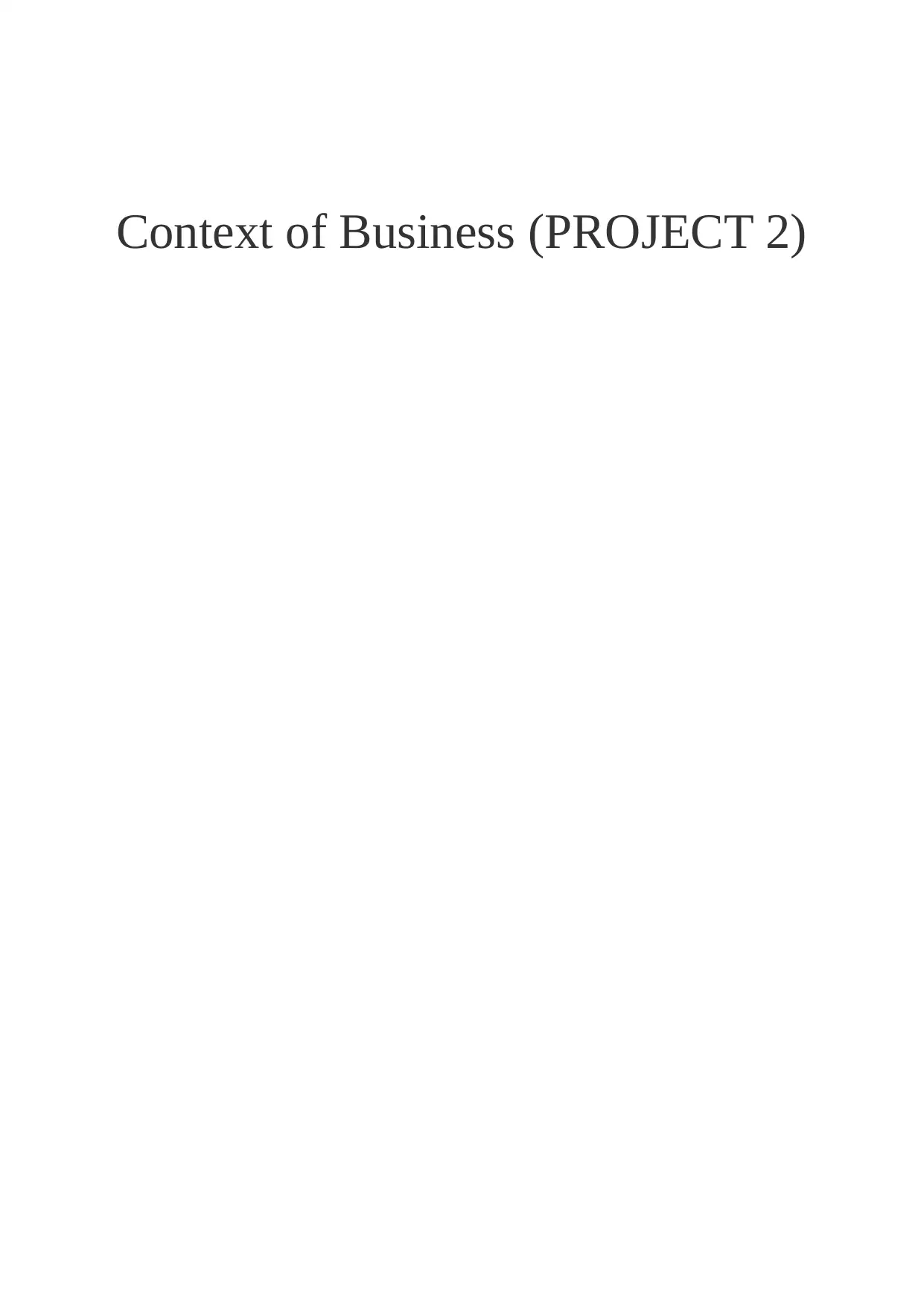
Context of Business (PROJECT 2)
Paraphrase This Document
Need a fresh take? Get an instant paraphrase of this document with our AI Paraphraser

Table of Contents
INTRODUCTION................................................................................................................................3
MAIN BODY.......................................................................................................................................3
LO 3 .....................................................................................................................................................3
Brief history and summary of business............................................................................................3
Defining vision, leadership style, management practices and organisational culture for the
development of people.....................................................................................................................4
LO 4 .....................................................................................................................................................5
Defining culture and management style influencing business functions and strategies..................5
LO 5 .....................................................................................................................................................6
Recommendations............................................................................................................................6
CONCLUSION....................................................................................................................................7
REFERENCES.....................................................................................................................................8
INTRODUCTION................................................................................................................................3
MAIN BODY.......................................................................................................................................3
LO 3 .....................................................................................................................................................3
Brief history and summary of business............................................................................................3
Defining vision, leadership style, management practices and organisational culture for the
development of people.....................................................................................................................4
LO 4 .....................................................................................................................................................5
Defining culture and management style influencing business functions and strategies..................5
LO 5 .....................................................................................................................................................6
Recommendations............................................................................................................................6
CONCLUSION....................................................................................................................................7
REFERENCES.....................................................................................................................................8
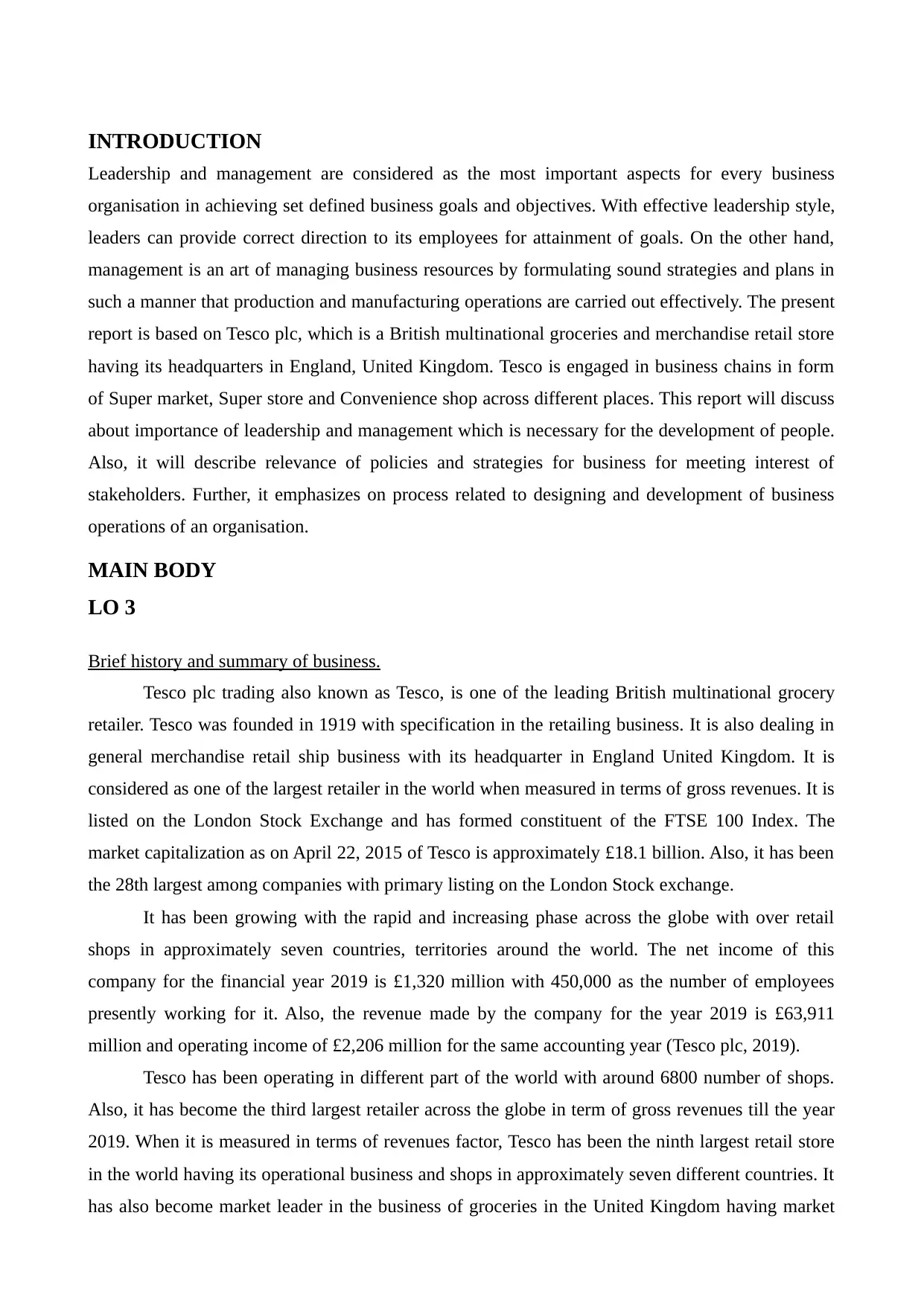
INTRODUCTION
Leadership and management are considered as the most important aspects for every business
organisation in achieving set defined business goals and objectives. With effective leadership style,
leaders can provide correct direction to its employees for attainment of goals. On the other hand,
management is an art of managing business resources by formulating sound strategies and plans in
such a manner that production and manufacturing operations are carried out effectively. The present
report is based on Tesco plc, which is a British multinational groceries and merchandise retail store
having its headquarters in England, United Kingdom. Tesco is engaged in business chains in form
of Super market, Super store and Convenience shop across different places. This report will discuss
about importance of leadership and management which is necessary for the development of people.
Also, it will describe relevance of policies and strategies for business for meeting interest of
stakeholders. Further, it emphasizes on process related to designing and development of business
operations of an organisation.
MAIN BODY
LO 3
Brief history and summary of business.
Tesco plc trading also known as Tesco, is one of the leading British multinational grocery
retailer. Tesco was founded in 1919 with specification in the retailing business. It is also dealing in
general merchandise retail ship business with its headquarter in England United Kingdom. It is
considered as one of the largest retailer in the world when measured in terms of gross revenues. It is
listed on the London Stock Exchange and has formed constituent of the FTSE 100 Index. The
market capitalization as on April 22, 2015 of Tesco is approximately £18.1 billion. Also, it has been
the 28th largest among companies with primary listing on the London Stock exchange.
It has been growing with the rapid and increasing phase across the globe with over retail
shops in approximately seven countries, territories around the world. The net income of this
company for the financial year 2019 is £1,320 million with 450,000 as the number of employees
presently working for it. Also, the revenue made by the company for the year 2019 is £63,911
million and operating income of £2,206 million for the same accounting year (Tesco plc, 2019).
Tesco has been operating in different part of the world with around 6800 number of shops.
Also, it has become the third largest retailer across the globe in term of gross revenues till the year
2019. When it is measured in terms of revenues factor, Tesco has been the ninth largest retail store
in the world having its operational business and shops in approximately seven different countries. It
has also become market leader in the business of groceries in the United Kingdom having market
Leadership and management are considered as the most important aspects for every business
organisation in achieving set defined business goals and objectives. With effective leadership style,
leaders can provide correct direction to its employees for attainment of goals. On the other hand,
management is an art of managing business resources by formulating sound strategies and plans in
such a manner that production and manufacturing operations are carried out effectively. The present
report is based on Tesco plc, which is a British multinational groceries and merchandise retail store
having its headquarters in England, United Kingdom. Tesco is engaged in business chains in form
of Super market, Super store and Convenience shop across different places. This report will discuss
about importance of leadership and management which is necessary for the development of people.
Also, it will describe relevance of policies and strategies for business for meeting interest of
stakeholders. Further, it emphasizes on process related to designing and development of business
operations of an organisation.
MAIN BODY
LO 3
Brief history and summary of business.
Tesco plc trading also known as Tesco, is one of the leading British multinational grocery
retailer. Tesco was founded in 1919 with specification in the retailing business. It is also dealing in
general merchandise retail ship business with its headquarter in England United Kingdom. It is
considered as one of the largest retailer in the world when measured in terms of gross revenues. It is
listed on the London Stock Exchange and has formed constituent of the FTSE 100 Index. The
market capitalization as on April 22, 2015 of Tesco is approximately £18.1 billion. Also, it has been
the 28th largest among companies with primary listing on the London Stock exchange.
It has been growing with the rapid and increasing phase across the globe with over retail
shops in approximately seven countries, territories around the world. The net income of this
company for the financial year 2019 is £1,320 million with 450,000 as the number of employees
presently working for it. Also, the revenue made by the company for the year 2019 is £63,911
million and operating income of £2,206 million for the same accounting year (Tesco plc, 2019).
Tesco has been operating in different part of the world with around 6800 number of shops.
Also, it has become the third largest retailer across the globe in term of gross revenues till the year
2019. When it is measured in terms of revenues factor, Tesco has been the ninth largest retail store
in the world having its operational business and shops in approximately seven different countries. It
has also become market leader in the business of groceries in the United Kingdom having market
⊘ This is a preview!⊘
Do you want full access?
Subscribe today to unlock all pages.

Trusted by 1+ million students worldwide
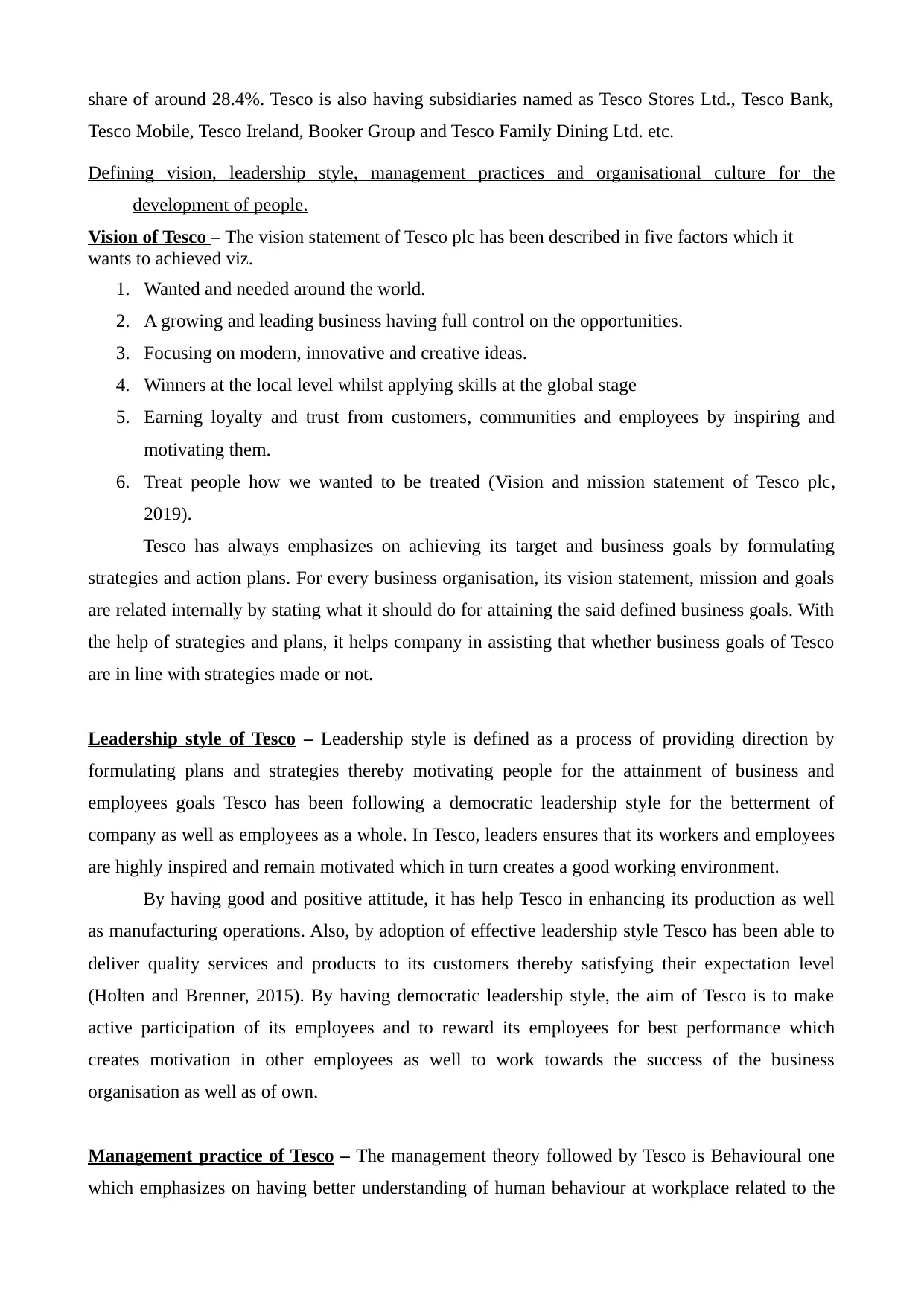
share of around 28.4%. Tesco is also having subsidiaries named as Tesco Stores Ltd., Tesco Bank,
Tesco Mobile, Tesco Ireland, Booker Group and Tesco Family Dining Ltd. etc.
Defining vision, leadership style, management practices and organisational culture for the
development of people.
Vision of Tesco – The vision statement of Tesco plc has been described in five factors which it
wants to achieved viz.
1. Wanted and needed around the world.
2. A growing and leading business having full control on the opportunities.
3. Focusing on modern, innovative and creative ideas.
4. Winners at the local level whilst applying skills at the global stage
5. Earning loyalty and trust from customers, communities and employees by inspiring and
motivating them.
6. Treat people how we wanted to be treated (Vision and mission statement of Tesco plc,
2019).
Tesco has always emphasizes on achieving its target and business goals by formulating
strategies and action plans. For every business organisation, its vision statement, mission and goals
are related internally by stating what it should do for attaining the said defined business goals. With
the help of strategies and plans, it helps company in assisting that whether business goals of Tesco
are in line with strategies made or not.
Leadership style of Tesco – Leadership style is defined as a process of providing direction by
formulating plans and strategies thereby motivating people for the attainment of business and
employees goals Tesco has been following a democratic leadership style for the betterment of
company as well as employees as a whole. In Tesco, leaders ensures that its workers and employees
are highly inspired and remain motivated which in turn creates a good working environment.
By having good and positive attitude, it has help Tesco in enhancing its production as well
as manufacturing operations. Also, by adoption of effective leadership style Tesco has been able to
deliver quality services and products to its customers thereby satisfying their expectation level
(Holten and Brenner, 2015). By having democratic leadership style, the aim of Tesco is to make
active participation of its employees and to reward its employees for best performance which
creates motivation in other employees as well to work towards the success of the business
organisation as well as of own.
Management practice of Tesco – The management theory followed by Tesco is Behavioural one
which emphasizes on having better understanding of human behaviour at workplace related to the
Tesco Mobile, Tesco Ireland, Booker Group and Tesco Family Dining Ltd. etc.
Defining vision, leadership style, management practices and organisational culture for the
development of people.
Vision of Tesco – The vision statement of Tesco plc has been described in five factors which it
wants to achieved viz.
1. Wanted and needed around the world.
2. A growing and leading business having full control on the opportunities.
3. Focusing on modern, innovative and creative ideas.
4. Winners at the local level whilst applying skills at the global stage
5. Earning loyalty and trust from customers, communities and employees by inspiring and
motivating them.
6. Treat people how we wanted to be treated (Vision and mission statement of Tesco plc,
2019).
Tesco has always emphasizes on achieving its target and business goals by formulating
strategies and action plans. For every business organisation, its vision statement, mission and goals
are related internally by stating what it should do for attaining the said defined business goals. With
the help of strategies and plans, it helps company in assisting that whether business goals of Tesco
are in line with strategies made or not.
Leadership style of Tesco – Leadership style is defined as a process of providing direction by
formulating plans and strategies thereby motivating people for the attainment of business and
employees goals Tesco has been following a democratic leadership style for the betterment of
company as well as employees as a whole. In Tesco, leaders ensures that its workers and employees
are highly inspired and remain motivated which in turn creates a good working environment.
By having good and positive attitude, it has help Tesco in enhancing its production as well
as manufacturing operations. Also, by adoption of effective leadership style Tesco has been able to
deliver quality services and products to its customers thereby satisfying their expectation level
(Holten and Brenner, 2015). By having democratic leadership style, the aim of Tesco is to make
active participation of its employees and to reward its employees for best performance which
creates motivation in other employees as well to work towards the success of the business
organisation as well as of own.
Management practice of Tesco – The management theory followed by Tesco is Behavioural one
which emphasizes on having better understanding of human behaviour at workplace related to the
Paraphrase This Document
Need a fresh take? Get an instant paraphrase of this document with our AI Paraphraser
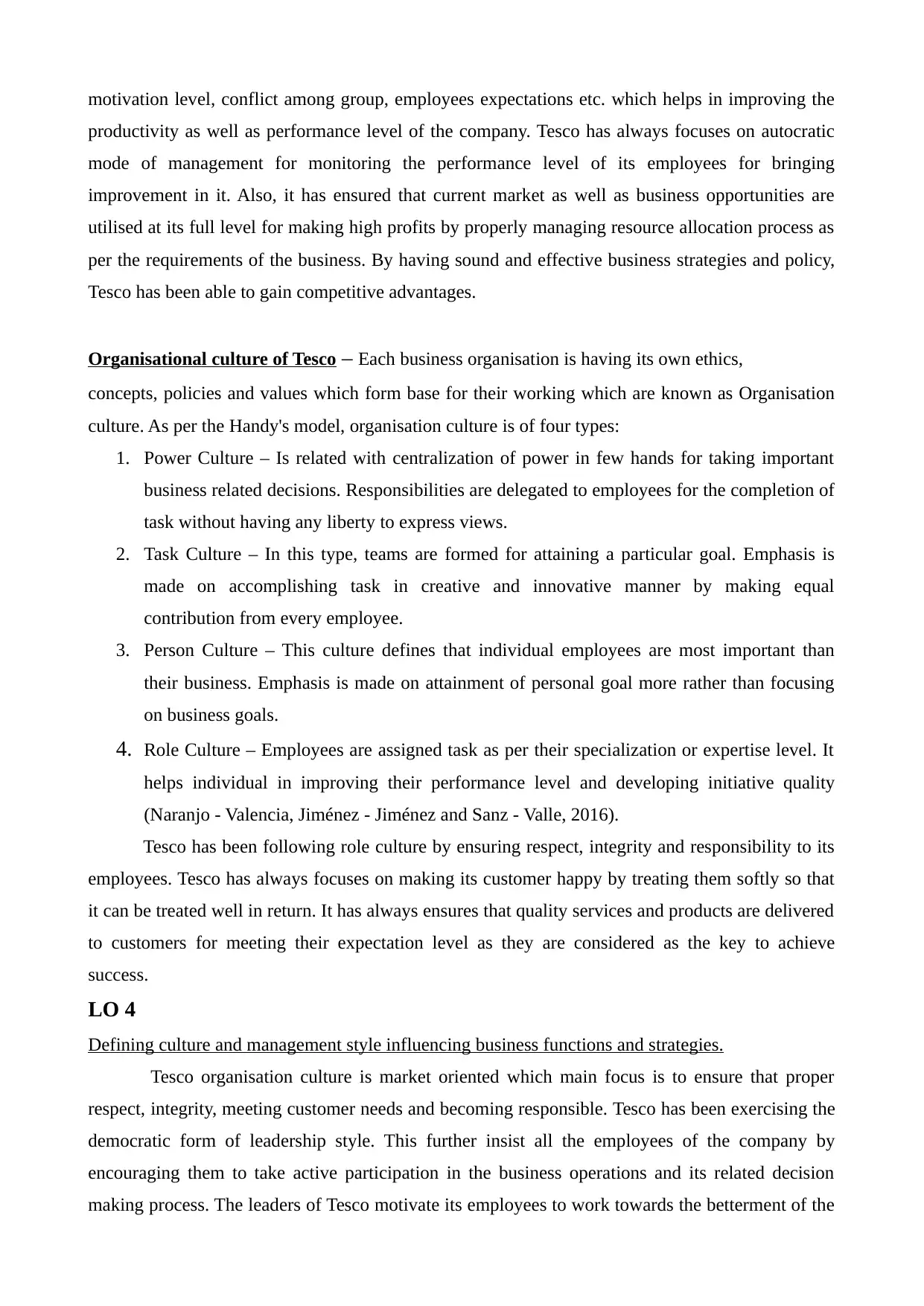
motivation level, conflict among group, employees expectations etc. which helps in improving the
productivity as well as performance level of the company. Tesco has always focuses on autocratic
mode of management for monitoring the performance level of its employees for bringing
improvement in it. Also, it has ensured that current market as well as business opportunities are
utilised at its full level for making high profits by properly managing resource allocation process as
per the requirements of the business. By having sound and effective business strategies and policy,
Tesco has been able to gain competitive advantages.
Organisational culture of Tesco – Each business organisation is having its own ethics,
concepts, policies and values which form base for their working which are known as Organisation
culture. As per the Handy's model, organisation culture is of four types:
1. Power Culture – Is related with centralization of power in few hands for taking important
business related decisions. Responsibilities are delegated to employees for the completion of
task without having any liberty to express views.
2. Task Culture – In this type, teams are formed for attaining a particular goal. Emphasis is
made on accomplishing task in creative and innovative manner by making equal
contribution from every employee.
3. Person Culture – This culture defines that individual employees are most important than
their business. Emphasis is made on attainment of personal goal more rather than focusing
on business goals.
4. Role Culture – Employees are assigned task as per their specialization or expertise level. It
helps individual in improving their performance level and developing initiative quality
(Naranjo - Valencia, Jiménez - Jiménez and Sanz - Valle, 2016).
Tesco has been following role culture by ensuring respect, integrity and responsibility to its
employees. Tesco has always focuses on making its customer happy by treating them softly so that
it can be treated well in return. It has always ensures that quality services and products are delivered
to customers for meeting their expectation level as they are considered as the key to achieve
success.
LO 4
Defining culture and management style influencing business functions and strategies.
Tesco organisation culture is market oriented which main focus is to ensure that proper
respect, integrity, meeting customer needs and becoming responsible. Tesco has been exercising the
democratic form of leadership style. This further insist all the employees of the company by
encouraging them to take active participation in the business operations and its related decision
making process. The leaders of Tesco motivate its employees to work towards the betterment of the
productivity as well as performance level of the company. Tesco has always focuses on autocratic
mode of management for monitoring the performance level of its employees for bringing
improvement in it. Also, it has ensured that current market as well as business opportunities are
utilised at its full level for making high profits by properly managing resource allocation process as
per the requirements of the business. By having sound and effective business strategies and policy,
Tesco has been able to gain competitive advantages.
Organisational culture of Tesco – Each business organisation is having its own ethics,
concepts, policies and values which form base for their working which are known as Organisation
culture. As per the Handy's model, organisation culture is of four types:
1. Power Culture – Is related with centralization of power in few hands for taking important
business related decisions. Responsibilities are delegated to employees for the completion of
task without having any liberty to express views.
2. Task Culture – In this type, teams are formed for attaining a particular goal. Emphasis is
made on accomplishing task in creative and innovative manner by making equal
contribution from every employee.
3. Person Culture – This culture defines that individual employees are most important than
their business. Emphasis is made on attainment of personal goal more rather than focusing
on business goals.
4. Role Culture – Employees are assigned task as per their specialization or expertise level. It
helps individual in improving their performance level and developing initiative quality
(Naranjo - Valencia, Jiménez - Jiménez and Sanz - Valle, 2016).
Tesco has been following role culture by ensuring respect, integrity and responsibility to its
employees. Tesco has always focuses on making its customer happy by treating them softly so that
it can be treated well in return. It has always ensures that quality services and products are delivered
to customers for meeting their expectation level as they are considered as the key to achieve
success.
LO 4
Defining culture and management style influencing business functions and strategies.
Tesco organisation culture is market oriented which main focus is to ensure that proper
respect, integrity, meeting customer needs and becoming responsible. Tesco has been exercising the
democratic form of leadership style. This further insist all the employees of the company by
encouraging them to take active participation in the business operations and its related decision
making process. The leaders of Tesco motivate its employees to work towards the betterment of the
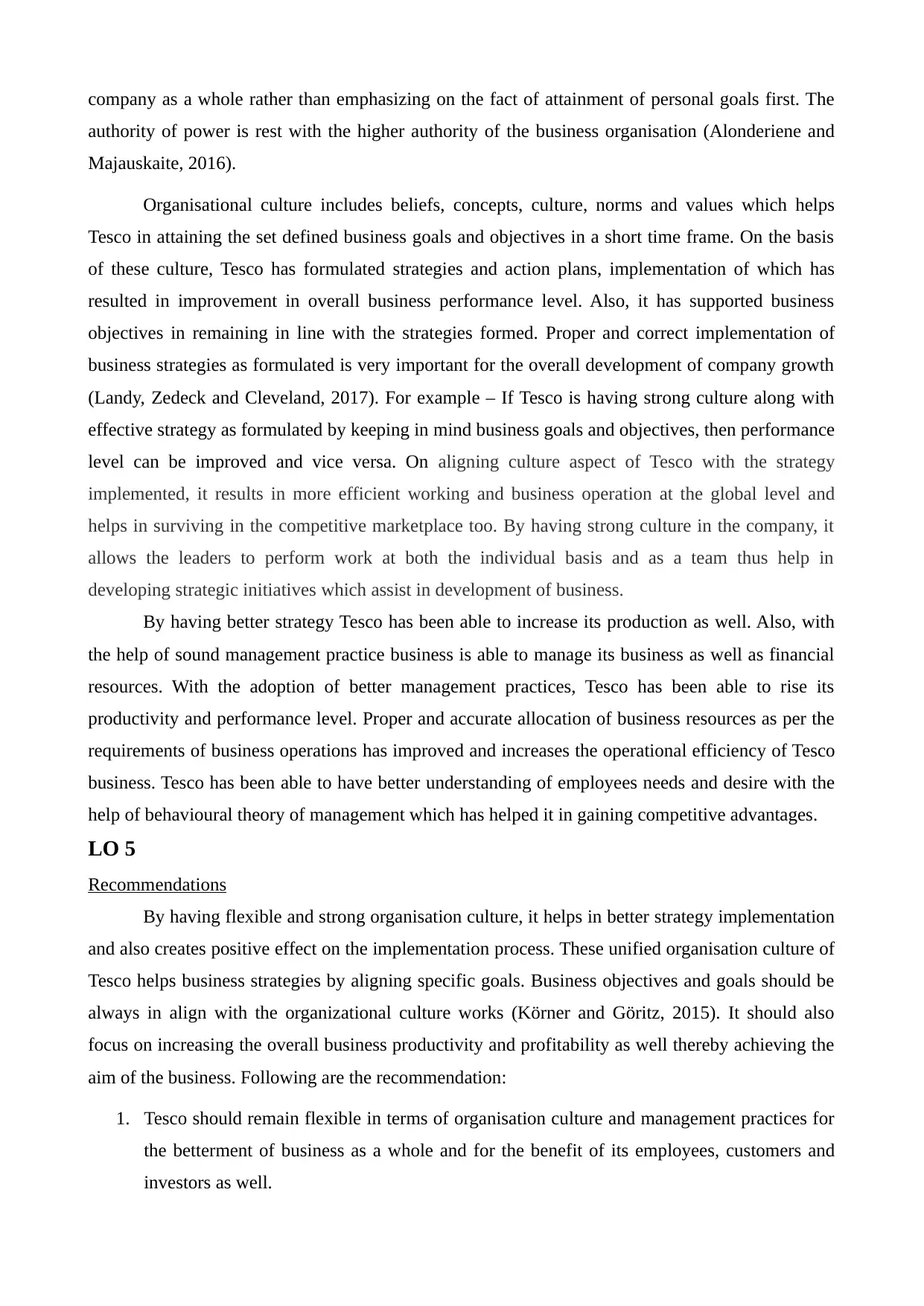
company as a whole rather than emphasizing on the fact of attainment of personal goals first. The
authority of power is rest with the higher authority of the business organisation (Alonderiene and
Majauskaite, 2016).
Organisational culture includes beliefs, concepts, culture, norms and values which helps
Tesco in attaining the set defined business goals and objectives in a short time frame. On the basis
of these culture, Tesco has formulated strategies and action plans, implementation of which has
resulted in improvement in overall business performance level. Also, it has supported business
objectives in remaining in line with the strategies formed. Proper and correct implementation of
business strategies as formulated is very important for the overall development of company growth
(Landy, Zedeck and Cleveland, 2017). For example – If Tesco is having strong culture along with
effective strategy as formulated by keeping in mind business goals and objectives, then performance
level can be improved and vice versa. On aligning culture aspect of Tesco with the strategy
implemented, it results in more efficient working and business operation at the global level and
helps in surviving in the competitive marketplace too. By having strong culture in the company, it
allows the leaders to perform work at both the individual basis and as a team thus help in
developing strategic initiatives which assist in development of business.
By having better strategy Tesco has been able to increase its production as well. Also, with
the help of sound management practice business is able to manage its business as well as financial
resources. With the adoption of better management practices, Tesco has been able to rise its
productivity and performance level. Proper and accurate allocation of business resources as per the
requirements of business operations has improved and increases the operational efficiency of Tesco
business. Tesco has been able to have better understanding of employees needs and desire with the
help of behavioural theory of management which has helped it in gaining competitive advantages.
LO 5
Recommendations
By having flexible and strong organisation culture, it helps in better strategy implementation
and also creates positive effect on the implementation process. These unified organisation culture of
Tesco helps business strategies by aligning specific goals. Business objectives and goals should be
always in align with the organizational culture works (Körner and Göritz, 2015). It should also
focus on increasing the overall business productivity and profitability as well thereby achieving the
aim of the business. Following are the recommendation:
1. Tesco should remain flexible in terms of organisation culture and management practices for
the betterment of business as a whole and for the benefit of its employees, customers and
investors as well.
authority of power is rest with the higher authority of the business organisation (Alonderiene and
Majauskaite, 2016).
Organisational culture includes beliefs, concepts, culture, norms and values which helps
Tesco in attaining the set defined business goals and objectives in a short time frame. On the basis
of these culture, Tesco has formulated strategies and action plans, implementation of which has
resulted in improvement in overall business performance level. Also, it has supported business
objectives in remaining in line with the strategies formed. Proper and correct implementation of
business strategies as formulated is very important for the overall development of company growth
(Landy, Zedeck and Cleveland, 2017). For example – If Tesco is having strong culture along with
effective strategy as formulated by keeping in mind business goals and objectives, then performance
level can be improved and vice versa. On aligning culture aspect of Tesco with the strategy
implemented, it results in more efficient working and business operation at the global level and
helps in surviving in the competitive marketplace too. By having strong culture in the company, it
allows the leaders to perform work at both the individual basis and as a team thus help in
developing strategic initiatives which assist in development of business.
By having better strategy Tesco has been able to increase its production as well. Also, with
the help of sound management practice business is able to manage its business as well as financial
resources. With the adoption of better management practices, Tesco has been able to rise its
productivity and performance level. Proper and accurate allocation of business resources as per the
requirements of business operations has improved and increases the operational efficiency of Tesco
business. Tesco has been able to have better understanding of employees needs and desire with the
help of behavioural theory of management which has helped it in gaining competitive advantages.
LO 5
Recommendations
By having flexible and strong organisation culture, it helps in better strategy implementation
and also creates positive effect on the implementation process. These unified organisation culture of
Tesco helps business strategies by aligning specific goals. Business objectives and goals should be
always in align with the organizational culture works (Körner and Göritz, 2015). It should also
focus on increasing the overall business productivity and profitability as well thereby achieving the
aim of the business. Following are the recommendation:
1. Tesco should remain flexible in terms of organisation culture and management practices for
the betterment of business as a whole and for the benefit of its employees, customers and
investors as well.
⊘ This is a preview!⊘
Do you want full access?
Subscribe today to unlock all pages.

Trusted by 1+ million students worldwide
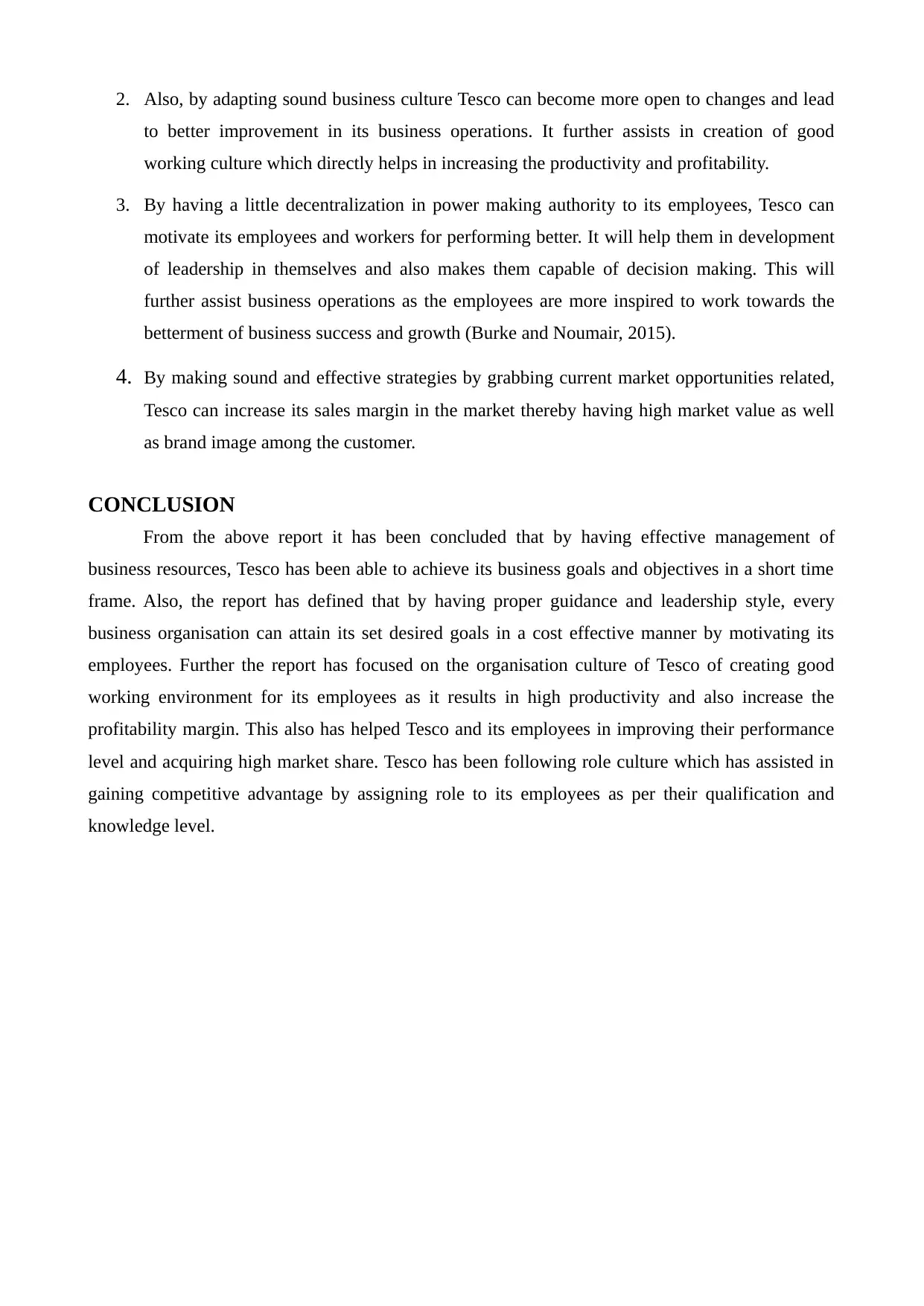
2. Also, by adapting sound business culture Tesco can become more open to changes and lead
to better improvement in its business operations. It further assists in creation of good
working culture which directly helps in increasing the productivity and profitability.
3. By having a little decentralization in power making authority to its employees, Tesco can
motivate its employees and workers for performing better. It will help them in development
of leadership in themselves and also makes them capable of decision making. This will
further assist business operations as the employees are more inspired to work towards the
betterment of business success and growth (Burke and Noumair, 2015).
4. By making sound and effective strategies by grabbing current market opportunities related,
Tesco can increase its sales margin in the market thereby having high market value as well
as brand image among the customer.
CONCLUSION
From the above report it has been concluded that by having effective management of
business resources, Tesco has been able to achieve its business goals and objectives in a short time
frame. Also, the report has defined that by having proper guidance and leadership style, every
business organisation can attain its set desired goals in a cost effective manner by motivating its
employees. Further the report has focused on the organisation culture of Tesco of creating good
working environment for its employees as it results in high productivity and also increase the
profitability margin. This also has helped Tesco and its employees in improving their performance
level and acquiring high market share. Tesco has been following role culture which has assisted in
gaining competitive advantage by assigning role to its employees as per their qualification and
knowledge level.
to better improvement in its business operations. It further assists in creation of good
working culture which directly helps in increasing the productivity and profitability.
3. By having a little decentralization in power making authority to its employees, Tesco can
motivate its employees and workers for performing better. It will help them in development
of leadership in themselves and also makes them capable of decision making. This will
further assist business operations as the employees are more inspired to work towards the
betterment of business success and growth (Burke and Noumair, 2015).
4. By making sound and effective strategies by grabbing current market opportunities related,
Tesco can increase its sales margin in the market thereby having high market value as well
as brand image among the customer.
CONCLUSION
From the above report it has been concluded that by having effective management of
business resources, Tesco has been able to achieve its business goals and objectives in a short time
frame. Also, the report has defined that by having proper guidance and leadership style, every
business organisation can attain its set desired goals in a cost effective manner by motivating its
employees. Further the report has focused on the organisation culture of Tesco of creating good
working environment for its employees as it results in high productivity and also increase the
profitability margin. This also has helped Tesco and its employees in improving their performance
level and acquiring high market share. Tesco has been following role culture which has assisted in
gaining competitive advantage by assigning role to its employees as per their qualification and
knowledge level.
Paraphrase This Document
Need a fresh take? Get an instant paraphrase of this document with our AI Paraphraser
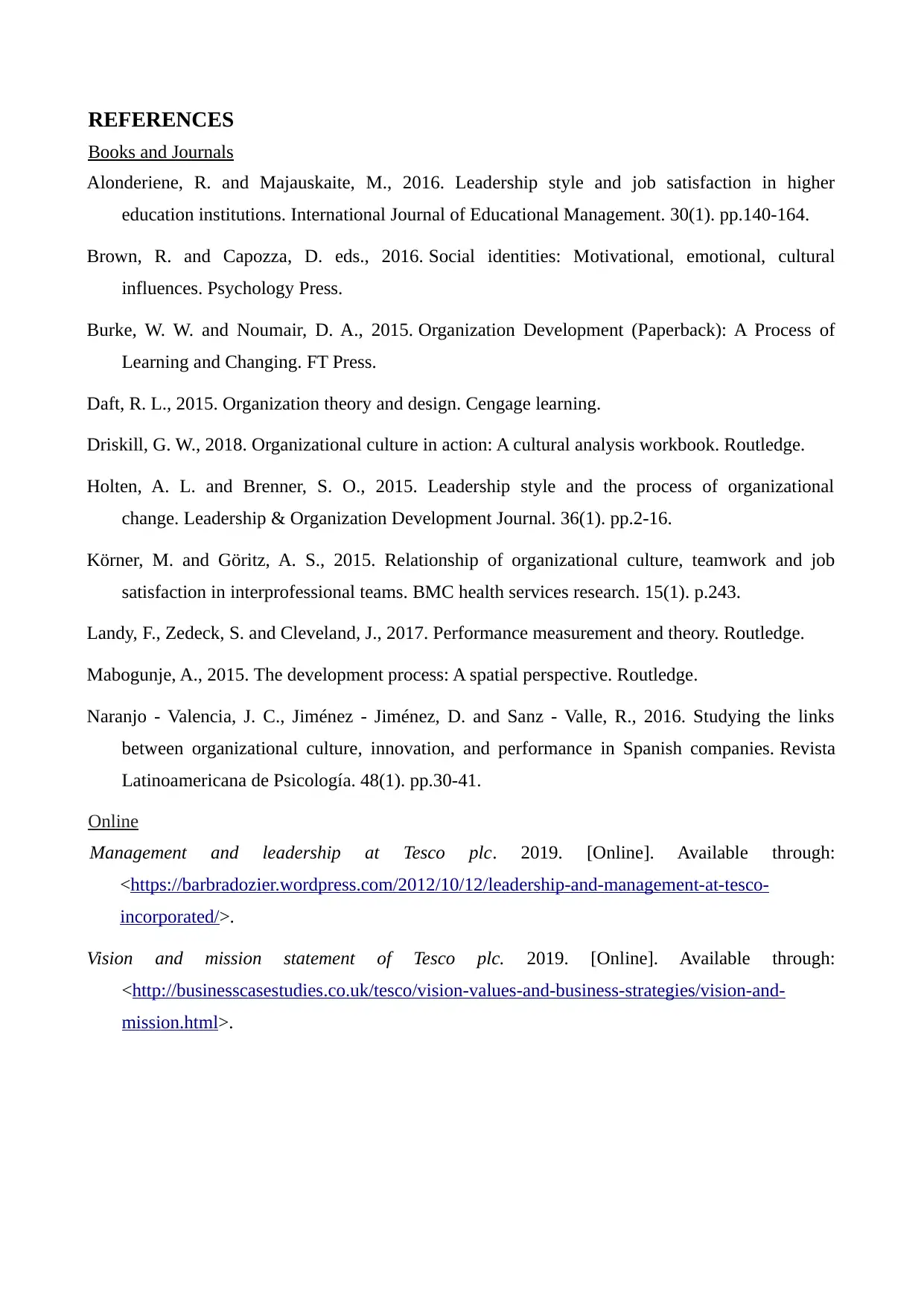
REFERENCES
Books and Journals
Alonderiene, R. and Majauskaite, M., 2016. Leadership style and job satisfaction in higher
education institutions. International Journal of Educational Management. 30(1). pp.140-164.
Brown, R. and Capozza, D. eds., 2016. Social identities: Motivational, emotional, cultural
influences. Psychology Press.
Burke, W. W. and Noumair, D. A., 2015. Organization Development (Paperback): A Process of
Learning and Changing. FT Press.
Daft, R. L., 2015. Organization theory and design. Cengage learning.
Driskill, G. W., 2018. Organizational culture in action: A cultural analysis workbook. Routledge.
Holten, A. L. and Brenner, S. O., 2015. Leadership style and the process of organizational
change. Leadership & Organization Development Journal. 36(1). pp.2-16.
Körner, M. and Göritz, A. S., 2015. Relationship of organizational culture, teamwork and job
satisfaction in interprofessional teams. BMC health services research. 15(1). p.243.
Landy, F., Zedeck, S. and Cleveland, J., 2017. Performance measurement and theory. Routledge.
Mabogunje, A., 2015. The development process: A spatial perspective. Routledge.
Naranjo - Valencia, J. C., Jiménez - Jiménez, D. and Sanz - Valle, R., 2016. Studying the links
between organizational culture, innovation, and performance in Spanish companies. Revista
Latinoamericana de Psicología. 48(1). pp.30-41.
Online
Management and leadership at Tesco plc. 2019. [Online]. Available through:
<https://barbradozier.wordpress.com/2012/10/12/leadership-and-management-at-tesco-
incorporated/>.
Vision and mission statement of Tesco plc. 2019. [Online]. Available through:
<http://businesscasestudies.co.uk/tesco/vision-values-and-business-strategies/vision-and-
mission.html>.
Books and Journals
Alonderiene, R. and Majauskaite, M., 2016. Leadership style and job satisfaction in higher
education institutions. International Journal of Educational Management. 30(1). pp.140-164.
Brown, R. and Capozza, D. eds., 2016. Social identities: Motivational, emotional, cultural
influences. Psychology Press.
Burke, W. W. and Noumair, D. A., 2015. Organization Development (Paperback): A Process of
Learning and Changing. FT Press.
Daft, R. L., 2015. Organization theory and design. Cengage learning.
Driskill, G. W., 2018. Organizational culture in action: A cultural analysis workbook. Routledge.
Holten, A. L. and Brenner, S. O., 2015. Leadership style and the process of organizational
change. Leadership & Organization Development Journal. 36(1). pp.2-16.
Körner, M. and Göritz, A. S., 2015. Relationship of organizational culture, teamwork and job
satisfaction in interprofessional teams. BMC health services research. 15(1). p.243.
Landy, F., Zedeck, S. and Cleveland, J., 2017. Performance measurement and theory. Routledge.
Mabogunje, A., 2015. The development process: A spatial perspective. Routledge.
Naranjo - Valencia, J. C., Jiménez - Jiménez, D. and Sanz - Valle, R., 2016. Studying the links
between organizational culture, innovation, and performance in Spanish companies. Revista
Latinoamericana de Psicología. 48(1). pp.30-41.
Online
Management and leadership at Tesco plc. 2019. [Online]. Available through:
<https://barbradozier.wordpress.com/2012/10/12/leadership-and-management-at-tesco-
incorporated/>.
Vision and mission statement of Tesco plc. 2019. [Online]. Available through:
<http://businesscasestudies.co.uk/tesco/vision-values-and-business-strategies/vision-and-
mission.html>.
1 out of 8
Related Documents
Your All-in-One AI-Powered Toolkit for Academic Success.
+13062052269
info@desklib.com
Available 24*7 on WhatsApp / Email
![[object Object]](/_next/static/media/star-bottom.7253800d.svg)
Unlock your academic potential
Copyright © 2020–2025 A2Z Services. All Rights Reserved. Developed and managed by ZUCOL.





